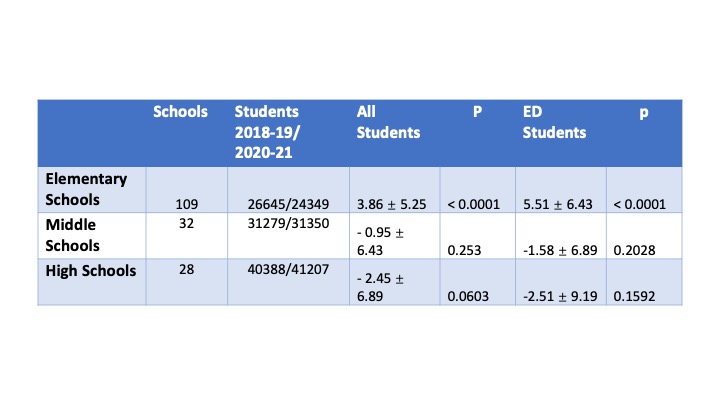Public Health & Prevention
Category: Abstract Submission
Public Health & Prevention I
562 - Association of Covid-19 and Economic Disadvantage with Chronic Absenteeism in Elementary Schools
Saturday, April 23, 2022
3:30 PM - 6:00 PM US MT
Poster Number: 562
Henry Rozycki, Children's Hospital of Richmond at VCU, Richmond, VA, United States; Mary A. Rozycki, Virginia Education Association, Richmond, VA, United States

Henry J. Rozycki, MD (he/him/his)
Vice-Chair
Children's Hospital of Richmond at VCU
Richmond, Virginia, United States
Presenting Author(s)
Background: Chronic school absenteeism (CA) is associated with poor academic performance, higher drop-out rates, lower adult income and poor lifetime health. Known factors contributing to CA include health issues, socioeconomic status and other environmental and equity-based stressors. If the Covid-19 pandemic, which affects many of these factors, leads to higher levels of CA, this could have long term health and welfare implications
Objective: The purpose of the study was to examine changes in CA among school children in Central Virginia between 2018-19 (pre-pandemic) and 2020-21 (in person learning).
Design/Methods: School data were obtained from the Virginia Department of Education School Quality Profiles website for all schools in the Richmond, Henrico and Chesterfield districts for 2018-19 (18-19) and 2020-21 (20-21). Enrollment, CA rate (% students absent > 10% school days), % economically disadvantaged (ED) (eligible for Free/Reduced Meals or receives Temporary Assistance for Needy Families or eligible for Medicaid; or a migrant or homeless) was recorded for each school. Covid-19 cases per 1000 people for each school zip code up to June 21, 2021 was obtained from the Virginia Department of Health website. Relationships between ED and covid case rate and CA rate and change in CA rate, were analyzed by regression analysis and t-test.
Results: Total enrollment fell between 18-19 and 20-21 from 98,312 to 96,906, primarily in elementary (Elem) children, which fell by 8.6%. As noted in the Table, there was a significant increase in overall CA and CA in ED children in the 109 Elementary schools but not in the 32 Middle or 28 High Schools. Among the Elem schools, there was a strong correlation between ED rate and CA rate (r = 0.71 for 18-19, r = 0.80 for 20-21, both p < 0.001) and between ED rate and the change in CA rate (r = 0.63, p < 0.001). The change in CA rate was 6.43 ± 4.92% for schools with ED rates in to top 50 percentile compared to 0.08 ± 2.91% for those in the bottom half, p < 0.0001. Covid case rate correlated to ED rate, r = 0.38, p = 0.00147. Elem schools in zip codes in the upper 50% percentile of Covid-19 rates saw an average CA increase of 6.51 ± 4.99% compared to 1.40 ± 4.18%, for the 50% with lower case rates, p < 0.0001.Conclusion(s): Elem CA increased almost 50% between the 2018-19 and 2020-21. The increase was associated with both the rate of ED and the rate of Covid-19 cases. This was not seen in older students. Since the Covid-19 case rate among Elem children was low in the study period, these finding may reflect resource challenges regarding Covid-19 for ED families.
Change in Chronic Absenteeism Rate (%) in All Students and Economically Disadvantaged Students between 2018-19 and 2020-21 Table 1
Table 1
Objective: The purpose of the study was to examine changes in CA among school children in Central Virginia between 2018-19 (pre-pandemic) and 2020-21 (in person learning).
Design/Methods: School data were obtained from the Virginia Department of Education School Quality Profiles website for all schools in the Richmond, Henrico and Chesterfield districts for 2018-19 (18-19) and 2020-21 (20-21). Enrollment, CA rate (% students absent > 10% school days), % economically disadvantaged (ED) (eligible for Free/Reduced Meals or receives Temporary Assistance for Needy Families or eligible for Medicaid; or a migrant or homeless) was recorded for each school. Covid-19 cases per 1000 people for each school zip code up to June 21, 2021 was obtained from the Virginia Department of Health website. Relationships between ED and covid case rate and CA rate and change in CA rate, were analyzed by regression analysis and t-test.
Results: Total enrollment fell between 18-19 and 20-21 from 98,312 to 96,906, primarily in elementary (Elem) children, which fell by 8.6%. As noted in the Table, there was a significant increase in overall CA and CA in ED children in the 109 Elementary schools but not in the 32 Middle or 28 High Schools. Among the Elem schools, there was a strong correlation between ED rate and CA rate (r = 0.71 for 18-19, r = 0.80 for 20-21, both p < 0.001) and between ED rate and the change in CA rate (r = 0.63, p < 0.001). The change in CA rate was 6.43 ± 4.92% for schools with ED rates in to top 50 percentile compared to 0.08 ± 2.91% for those in the bottom half, p < 0.0001. Covid case rate correlated to ED rate, r = 0.38, p = 0.00147. Elem schools in zip codes in the upper 50% percentile of Covid-19 rates saw an average CA increase of 6.51 ± 4.99% compared to 1.40 ± 4.18%, for the 50% with lower case rates, p < 0.0001.Conclusion(s): Elem CA increased almost 50% between the 2018-19 and 2020-21. The increase was associated with both the rate of ED and the rate of Covid-19 cases. This was not seen in older students. Since the Covid-19 case rate among Elem children was low in the study period, these finding may reflect resource challenges regarding Covid-19 for ED families.
Change in Chronic Absenteeism Rate (%) in All Students and Economically Disadvantaged Students between 2018-19 and 2020-21
 Table 1
Table 1